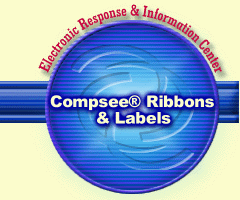Defining your needs - Media
The quality and durability of the printed image is
the most important element of your system. Don't overlook supplies
when outlining your requirements. Using the wrong label or ribbon
can literally mean the difference between success and failure.
Which label or label/ribbon combination is best
for your application?
Literally hundreds of combinations exist. Facestocks, adhesives
and ribbons must be carefully matched and tested to optimize both
printer and label performance. Every printed label must withstand
the environment of your application and remain both legible and
scannable during its entire life cycle, which could range from minutes
to years. In making your selection, take into account the following
key points:
Choose the right facestock.
Consider your usage environment and your requirements for label
life and image stability. The label you place on your product or
package may be subjected to all types of abuse. Facestock materials
fall within two broad classifications:
- Paper is the most common of all direct
thermal and thermal transfer stocks and is the least expensive. It
can be coated or uncoated to meet various requirements for print
quality and cost.
- Synthetics include, but are not limited to, polyester, vinyl
and mylar. These may be better suited than paper for applications
where the label is subjected to excessive abrasion, heat, ultra-violet
light, chemicals or other potentially destructive elements.
Select the right adhesive.
A variety of general purpose and specialty options are available
to meet a wide range of application requirements. Choose an adhesive
formulation that is matched to your needs.
- Some adhesives are permanent and will
keep a label in place even with exposure to temperature extremes,
high humidity, chemical immersion or outdoor use. Others can be
easily removed from any labeling surface without leaving a
residue. Still others are tamper-evident and will not come off in
one piece if removal is attempted.
- Be aware that some labeling surfaces are particularly difficult
to label. Specific adhesive formulations will be needed for certain
hard-to-label surfaces such as wood, recycled corrugate, refrigerated
materials and small, curved objects.
Select the right ribbon.
Match the ribbon to your facestock and application. Thermal transfer
ribbons come in a variety of lengths ranging from 300 meters to
600 meters and are available in three basic formulations:
- Wax-based ribbons, popular and low in
cost, are used with both paper and synthetic facestocks to produce
high-quality images that are durable enough for most applications.
However, images will smear or scratch off if subjected to abrasion
or heat.
- Resin-based ribbons produce very high
quality images on both paper and synthetic materials and are
resistant to smudging, abrasion, many chemicals and harsh
environments. For example, when matched with certain synthetic
stocks, some resin inks can withstand temperatures in excess of
1000 degrees Fahrenheit.
- Wax/resin ribbons combine the advantages of both, offering higher
durability than wax at a lower cost than resin-based products.
Regardless of your application, you must first define
the item to be labeled, the required label life and the usage environment.
Once you have found a possible solution, test and re-test printed
labels in your application to ensure continued success.
Reprinted with permission from Datamax
Corporation - 2000
Return
to Media Index
|
